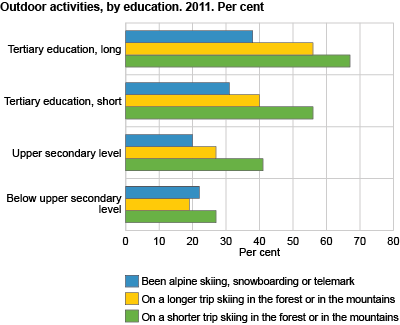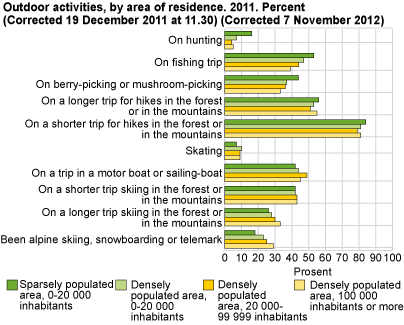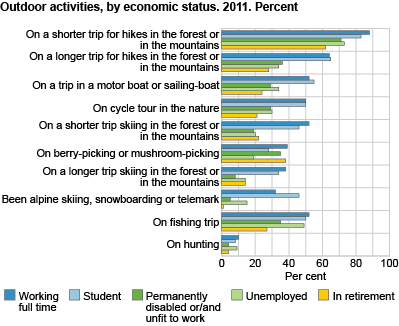Content
Published:
This is an archived release.
Highly educated go skiing most often
In the course of a year, eight out of ten Norwegians went hiking in the woods or the mountains. Four out of ten have been on shorter skiing trips, and those with a high education are most active.
The Survey of level of living 2011 examines outdoor activities of the Norwegian population. The results show that many were active. Eighty-one per cent of the population aged over 16 had been on one or more shorter hikes, while 54 per cent had been on a long hike in the woods or the mountains in the last 12 months. Many, i.e. 71 per cent of the population, have also bathed in salt or fresh water. Forty-two per cent of the population had been out in the nature with a bicycle.
City population took the most long ski trips
Forty-two per cent had been on one or more short skiing trips in the woods or in the mountains during a 12 month period, and 29 per cent had been on a long trip. A somewhat smaller percentage; 24 per cent, had been alpine skiing, snowboarding or Telemark skiing.
The population in Trøndelag, Oslo and Akershus did the most skiing, and half of the inhabitants in these cities had been on a shorter ski trip. The percentage that went on a long ski trip is highest in cities. Thirty-three per cent of residents in towns with more than 100 000 inhabitants had been on a long ski trip, compared with 26 per cent of those living in rural areas with less than 200 inhabitants.
Going skiing is clearly related with education level. The proportion who went skiing is twice as high among those with a university education compared with those with less education. Fifty-six per cent of the population with a four-year or longer university education had been on a long ski trip in the last 12 months, and among those with only compulsory schooling the corresponding figure was 19 per cent.
Employed and students were most active
Employed and students are generally more active than the unemployed, disabled and retired (for definition of groups, see About the statistics ). This is probably also related to differences in age and health status. The survey showed especially large differences with regard to walking, cycling, being on a boat trip or going skiing. With regard to outdoor activities such as berry or mushroom picking, or hunting and fishing, the differences between the groups were not as great.
More "useful" outdoor activities in rural areas
The share that has been berry or mushroom picking, hunting or fishing was higher among those living in rural areas, while going on a longer ski trip or alpine skiing were more common among the city dwellers. The percentage that had been on short and long walks in the nature, boating, cycling, horse riding, shorter skiing trips, skating or bathing during a 12 month period was about the same for those living in the city and those living in more rural areas.
Differences by age and gender
Younger people are generally more active than older people. The greatest age difference was found with regard to alpine skiing, snowboarding and Telemark skiing. Half of the population aged 16-24 years reported having done this in the course of a year, compared with 15 per cent of the population aged 45-66 years. Men were also more active than women. The greatest gender differences were found in fishing and hunting, but the differences have become less over time.
Fewer have been hunting, fishing, berry or mushroom picking
In the period 1997-2011, there has been a decline in the proportion of the population that has been hunting, fishing or berry or mushroom picking. In particular, there are fewer who have been mushroom or berry picking. In 1997, 56 per cent of the population reported that they had been berry or mushroom picking; the corresponding proportion was 37 per cent in 2011. Unlike most other outdoor activities, berry and mushroom picking are more prevalent among older than younger people. Thirty-six per cent of the population aged over 67 had performed this activity within a 12 month period and this is the third most common leisure activity in this age group. Together with horse riding, this is also the only outdoor activity where women are more active than men.
Break in series in measurement of outdoor activitiesIn the Survey of level of living 2011, some outdoor activities have been deleted and some of the questions have changed slightly compared to the years 1997-2007. First and foremost, the duration of some activities has changed. Earlier we distinguished between day and overnight trips, now we distinguish between short and long trips (over/under 3 hours). In addition to this, the collection method has changed. Previously, this data was obtained via the postal system, while the 2011 survey data was collected via telephone interviews (CATI).
The categories that can be compared with the previous surveys of living conditions are: Been berry or mushroom picking last 12 months Been on a hunting trip last 12 months Been fishing the last 12 months Been horseback riding in a natural setting Been skating last 12 months Been alpine skiing, snowboarding or Telemark skiing last 12 months Bathed in salt or fresh water the last 12 months |
Find more figures
Find detailed figures for Sports and outdoor activities, survey on living conditions
Contact
-
Håvard Bergesen Dalen
E-mail: havard.dalen@ssb.no
tel.: (+47) 40 90 23 50



